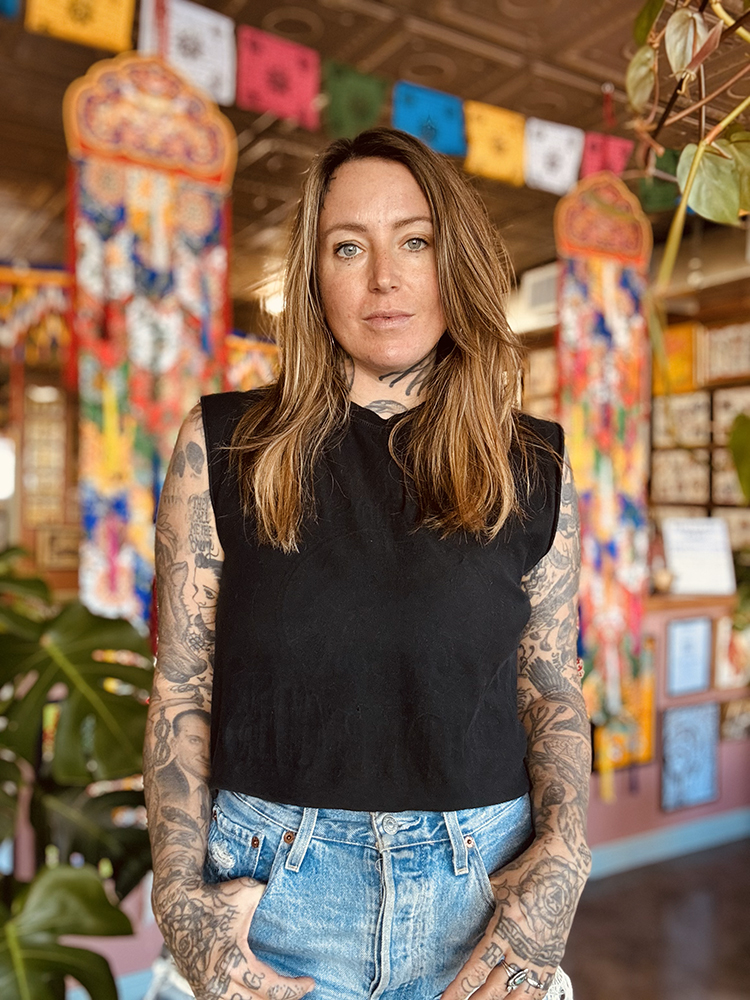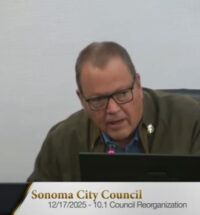By Larry Barnett
When I was growing up in the ‘50s the only tattoos I saw were on the arms of working men, either patriotic images of Stars and Stripes or hearts emblazoned with the word “Mother.” The world of tattoos has changed, however, and Jessie Marioni, born and raised here in Sonoma, is an example of just how much.
“I’d say 70 percent of our customers are women,” she noted as we talked, “Sometimes it’s a group of bachelorettes who all come in together.”
Jessie owns and operates Rosa Grande, a tattoo shop at 546 Broadway, just a stone’s throw from Sonoma City Hall. It doesn’t get more mainstream than that. She and a crew of seven tattoo artists offer their services to the public every day from noon until seven, and they enjoy a steady stream of customers.

“I got my first tattoo at age 14,” she tells me, “During a trip to Mexico I snuck off. I was just a punk kid. A got a small star on my ankle.” At the time she was going to school at St. Francis Solano. “My teachers were not impressed,” she added. That was just the beginning. Today Jess has tattoos from head to foot, right to the tips of her fingers.
After high school she moved to Oakland for a while to attend California College of the Arts, got a degree in fine arts, “got lost in the fray for a while,” joined a thriving counterculture of artists and punk and metal musicians, “that wild life.” At that time, Oakland also legalized medicinal cannabis consumption, and Jessie, in her words, “f’ked around going to underground art shows, playing music and making art. We were all getting tattooed.”
After graduating, she stayed in Oakland and was part of the music and tattoo scene. Eventually, in her words, she “pulled her head out of her ass” and, dedicated to being an artist, decided to stay true to that path. “I was covered in tattoos at that point, and I figured, maybe there’s something here to be passionate about.” This was fifteen years ago.
At that time tattooing was “still very secretive, pre-social media. But it was the time of TV shows like ‘Ink Master’, and all of a sudden tattooing was becoming more accessible across the U.S.,” she recalls. Tattooing is a permanent marking, even if ‘erased’ by laser, she explains. “Tattooing is the most ancient art form that human beings have.”
Tattooing is connected to the spiritual part of Jessie’s life. “There is an element of the esoteric about tattooing,” she offers, “there is something about it that’s sacred and can be very powerful on a spiritual level.” As she mentions this, she sits before a display of Christian Icons, Tibetan prayer flags, figurines and totems at her “station” in the shop. Ancient cultures practiced tattooing not simply as fashion, but also in rituals, she points out. “That element of tattooing still exists,” she explains.
She eventually returned to Sonoma and opened her shop in 2020. Her business in this cozy little town is up and down, but mostly steady. She and her coworkers stay busy. “I sometimes call tattoos ‘permanent jewelry,’” Jessica says. It may be, I suggest, that what we call art began with adorning the body with tattoos, and Jessica agrees. She thinks that women getting tattoos is also about making a bold choice about ‘my body.” And as a political statement?
We talked about Roger Stone’s tattoo of Richard Nixon on his back, and Secretary of Defense Pete Hegseth’s Iron Cross tattoo on his chest. “That man scares me,” she says. “There is a whole world of gang tattoos, Hells Angels, and Japan’s Yakuza for example.”
I brought up recent reports about tattoo health, toxic inks and the like. “I think it’s a valid concern,” she agrees, “there’s no regulations on tattoo pigment.” It’s up to each tattoo artist to purchase pigment from reputable companies, but the tools and pigments have become so popular they can now be bought on Amazon or Walmart. “It’s very inexpensive to buy now,” she says, “machines for $30 and pigments for next to nothing. I can’t speak to the safety of those pigments. I buy only from people I know personally who stay away from using microplastics or acrylics,” she says.
She explains that a tattoo sits between the dermis and epidermis and is quite stable. It’s very permanent. But she warns, non-professionals may not be as safe and may use non-reputable sources. Discussions about regulating pigments are happening. As for price, her shop charges a minimum of $100 for a tattoo.
Most customers already know what type of tattoo they want, providing photos or pictures that Jessie can “retrace” using a computer to finalize the design. I ask her if she’s worried that the technology of AI and robotics may replace her. “I think the human element is crucial, but I’ve already seen videos of robots tattooing. But I don’t think robots are going to steal my job. I believe in the artistic human element. These are conversations that we in the industry are having.”
“People want to be understood,” she concludes, “more so than anything else people want to have real life interactions and experiences. That’s what will save good tattoo shops.”






I see bad tattoos and good ones, just like I see bad art and good. But, you may say it is in the eyes of the beholder. I got my first tattoos around the time I turned 50. I am 73 now. My husband has never liked them. They have all been done by the same artist, because I love her work as an artist. I have never regretted getting them. Each one of them is a bit of art I look at each day and it lifts my spirits. I have a beautiful humming bird, drinking nectar from a flower, a dragonfly, a Koi fish with a water lily and a cute cat with his own tattoo of chrysanthemums on his body. Yet, there are people that dislike tattoos and sometimes stare at mine with a look of distaste. But, also people come up to me and tell me how beautiful they are.